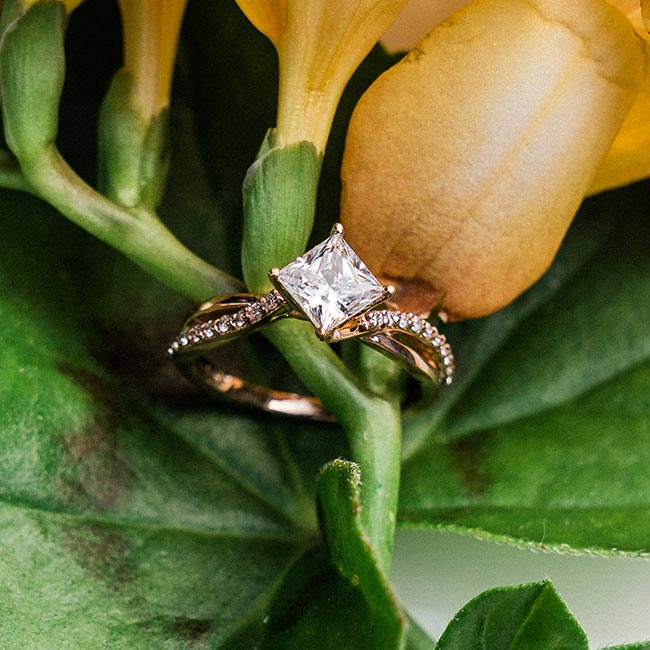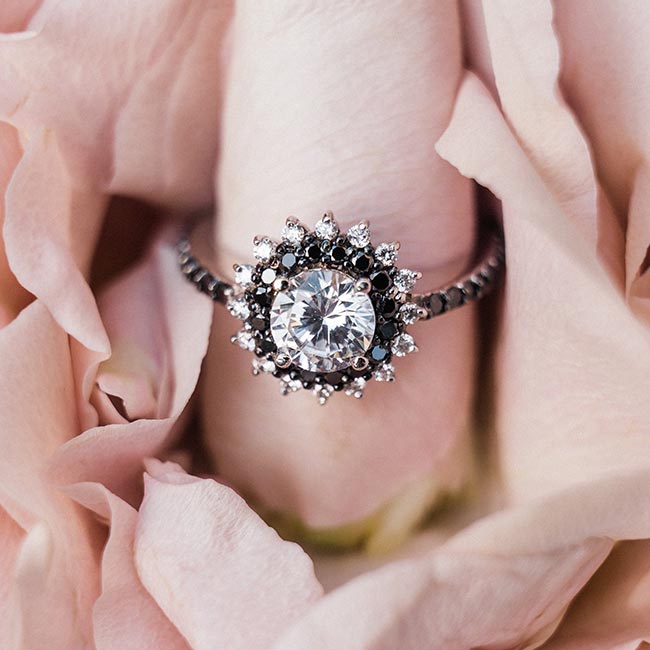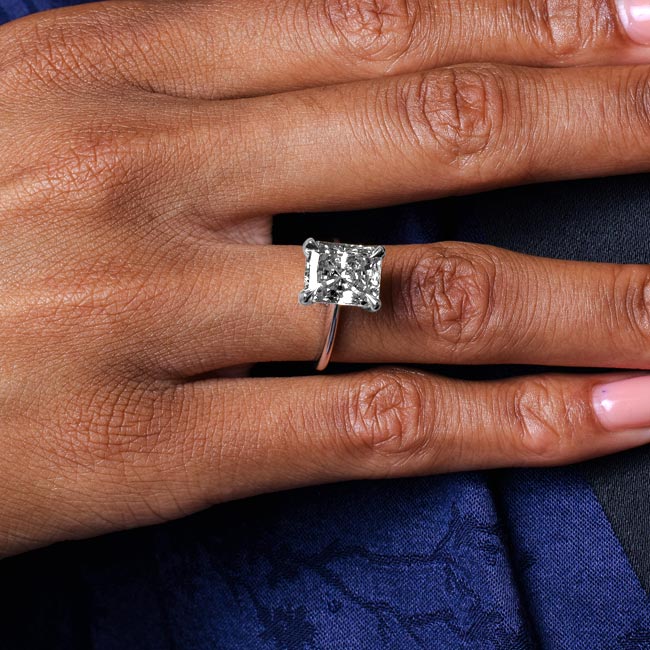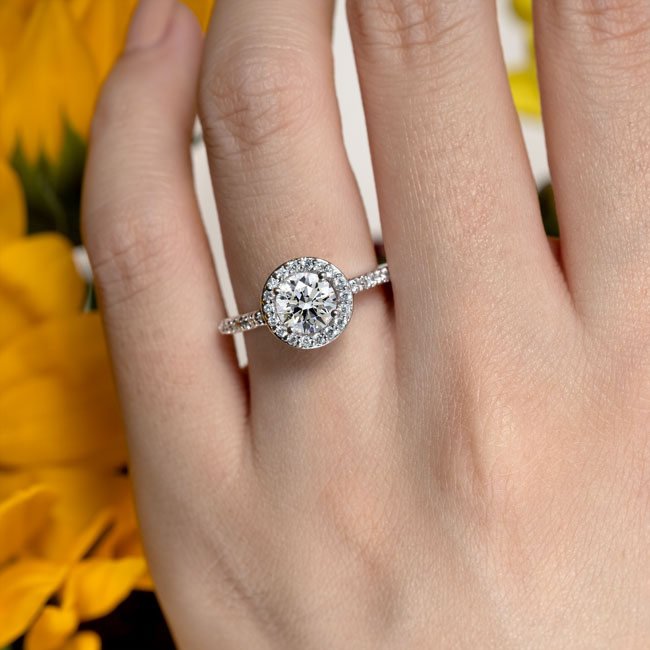Often, diamonds with lower clarity grades can look just as flawless to the naked eye as diamonds with Flawless (FL) or Internally Flawless (IF). Yet, they’ll cost hundreds or even thousands of dollars less. Choosing a slightly lower diamond clarity grade can help you save quite a lot of money, even while getting a diamond that looks absolutely beautiful and clear.
The key to choosing diamond clarity wisely is to be careful with the range you choose from. Often, people will start looking for value within the Very Slightly Include and Slightly Included range. These diamonds cost much less than higher graded diamonds, but none will have the glaringly obvious flaws that Included diamonds have. But what exactly is the difference between a VS diamond and an SI diamond? Which should you choose? Below, we’re going over every VS and SI grading to help you find the right diamond clarity grading for you.
VS1 Clarity

The official GIA description of Very Slightly Included clarity is “minor inclusions that range from difficult to somewhat easy to see are visible to a skilled grader using 10x magnification.” There are two levels within this category, with the better one being VS1.
Generally speaking, VS1 clarity diamonds look stunning to the naked eye. Though they’ll have minor inclusions under magnification, VS1 diamonds are almost always eye clean, which means you won’t be able to see flaws just by looking at the diamond. Even if you had a diamond loupe, you’d probably be hunting for a while to find the flaws that resulted in a VS1 diamond’s grade, especially because VS1 diamonds don’t have flaws in high relief areas (such as the center of the diamond). Durability-wise, VS1 diamonds also shine. Diamonds with this grade don’t have inclusions or blemishes that affect the structural integrity of the diamond.
So, should you choose this diamond clarity? It’s certainly not a bad choice! For high carat weight diamonds or step cut diamonds in particular, this can be a great budget clarity grade option that looks as gorgeous as a VVS1 or VVS2 clarity diamond. But for some diamond shapes and sizes, you may find that you can go even lower on the clarity grading scale and end up with the same look. Specifically, brilliant cut diamonds that are under two carats can often look stunning even with lower clarity gradings, since their many facets can obscure tiny flaws.
VS2 Clarity

VS2 is the slightly lower grade in the Very Slightly Included category. The GIA description of this clarity grade is the same as it is for VS1, but VS2 clarity diamonds will have slightly more flaws. VS2 clarity diamonds can have more of the same types of minor flaws that VS1 diamonds have. They may have many more tiny inclusions or just one or two larger inclusions.
With that said, VS2 is very often a good choice for those who are looking to maximize their budget. VS2 diamonds are still almost always eye clean, so they’re usually a fantastic budget option for those who are looking for a brilliant cut diamond for an engagement ring or another piece of diamond jewelry. However, if you’re searching for a step cut diamond, be a bit cautious about VS2 clarity diamonds. It’s very easy to see into the center of step cut diamonds, such as emerald cut and asscher cut diamonds, so it’s easier to spot flaws with the unaided eye. Because of this, most jewelers and gemologists will recommend that you prioritize clarity grade for step cut diamonds. Generally speaking, sticking with a clarity grading of VS1 or higher is best for step cut diamonds.
SI1 Clarity

Diamonds within the Slightly Included range can sometimes be eye clean, but they can also have flaws that are visible to the naked eye. Per the GIA, a diamond with Slightly Included clarity will have “inclusions [that] are noticeable to a skilled grader under 10x magnification.” These flaws that are “noticeable” under magnification can sometimes also be noticeable without magnification– it depends on the specific diamond.
The top grade in the Slightly Included category is SI1. Put simply, these diamonds are a risky choice. You can find SI1 clarity diamonds that look beautiful and clear, but that’s definitely not a guarantee with this clarity grade. SI1 diamonds can also feature very noticeable inclusions and flaws that can compromise durability, such as chips, etched channels, and feather inclusions along corners.
Since SI1 clarity is so variable, it’s not a grade we’d suggest buying without taking a very close look at the diamond in person. It’s also not a grade that we would generally recommend for an important piece of diamond jewelry, such as an engagement ring.
SI2 Clarity and SI3 Clarity

SI2 and SI3 are even more likely to have inclusions that are visible to the naked eye than SI1 diamonds. You’ll probably be able to see flaws on an SI2 or SI3 diamond if you look at it closely with an unaided eye. And, sometimes, you’ll also be able to see visible flaws from far away.
Since they often feature visible inclusions, should you ever choose an SI2 or SI3 diamond? Perhaps. It depends on what you’re looking for and how much seeing some visible flaws would bother you. It may also depend on where the flaws on the diamond are located. If there are obvious inclusions right in the center of a diamond, most people wouldn’t find it desirable. But if there are many smaller flaws in less noticeable locations, it’s possible that you’d still find the diamond pretty enough to be worn in diamond studs or another piece of jewelry that’s viewed from a distance. Still, we’d strongly suggest looking at a SI3 or SI2 diamond gemstone in person before purchasing it.
Final Thoughts: Consider Going VS2 or VS1
Ultimately, there’s no best diamond clarity for everyone. There’s only the diamond clarity grade that’s right for your aesthetic goals and budget considerations. For most people, a VS2 clarity diamond will be the sweet spot where beauty and value intersect. However, if you’re searching for a step cut diamond or a diamond that’s larger than two carats, you may want to spend a bit more for an even clearer VS1 diamond. Alternatively, if you’re looking for a brilliant cut diamond and are open to hunting for an eye clean diamond in person (or if you just don’t care much about the possibility of visible flaws), you could save money by selecting an SI1 diamond.


